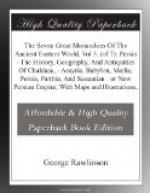The vegetable forms represented on the gems are sometimes graceful and pleasing. This is especially the case with palm-trees, a favorite subject of the artists, who delineated with remarkable success the feathery leaves, the pendant fruit and the rough bark of the stem. [PLATE LVIII., Fig 1.] The lion-hunter represented on the signet-cylinder of Darius Hystaspis takes place in a palm-grove, and furnishes the accompanying example of this form of vegetable life.
[Illustration: PLATE LVIII.]
One gem, ascribed on somewhat doubtful grounds to the Persians of Achaemenian times, contains what appears to be a portrait. It is thought to be the bust of a satrap of Salamis in Cyprus, and is very carefully executed. If really of Persian workmanship, it would indicate a considerable advance in the power of representing the human countenance between the time of Darius Hystaspis and that of Alexander [PLATE LVII. Fig. 2.]
Persian coins are of three principal types. The earliest have on the one side the figure of a monarch bearing the diadem and armed with the bow and javelin, while on the other there is an irregular indentation of the same nature with the quadratum incusum of the Greeks. This rude form is replaced in later times by a second design, which is sometimes a horseman, sometimes the forepart of a ship, sometimes the king drawing an an arrow from his quiver. Another type exhibits on the obverse the monarch in combat with a lion while the reverse shows a galley, or a towered and battlemented city with two lions standing below it, back to back. The third common type has on the obverse the king in his chariot, with his charioteer in front of him, and (generally) an attendant carrying a fly-chaser behind. The reverse has either the trireme or the battlemented city. A specimen of each type is given. [PLATE LVII., Fig. 4.]
The artistic merit of these medals is not great. The relief is low, and the drawing generally somewhat rude. The head of the monarch in the early coins is greatly too large. The animal forms are, however, much superior to the human, and the horses which draw the royal chariot, the lions placed below the battlemented city, and the bulls which are found occasionally in the same position, must be pronounced truthful and spirited.
Of the Persian taste in furniture, utensils, personal ornaments and the like, we need say but little. The throne and footstool of the monarch are the only pieces of furniture represented in the sculptures, and these, though sufficiently elegant in their forms, are not very remarkable. Costliness of material seems to have been more prized than beauty of shape; and variety appears to have been carefully eschewed, one single uniform type of each article occurring in all the representations. The utensils represented are likewise few in number, and limited to certain constantly repeated forms. The most elaborate is the censer, which has been already given.




